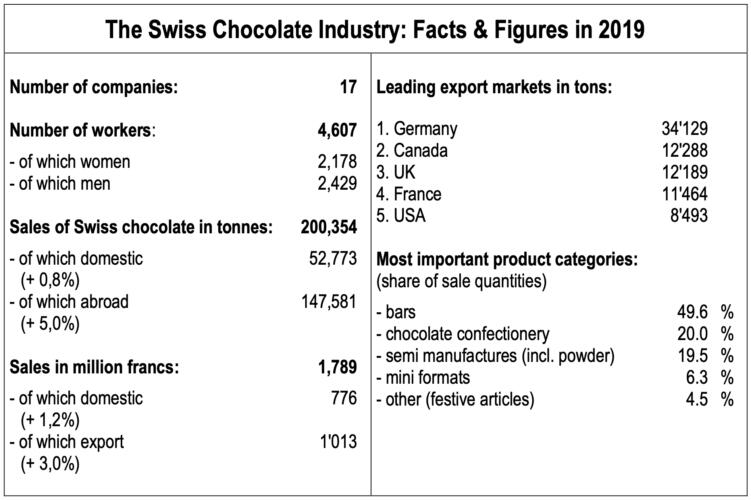The Swiss chocolate industry 2019
Swiss chocolate: export business is essential
Following the drop in chocolate consumption in Switzerland over the past ten years, there were signs of stabilisation in 2019. Despite continuing pressure from imports, more than 200,000 metric tons of chocolate were produced in Switzerland for the first time last year thanks to demand from abroad. The associated economies of scale are also important within Switzerland.
After declining significantly in previous years, domestic consumption bottomed out in 2019. The growth in export business enabled the production of Swiss chocolate to rise by 3.8% to around 200,000 metric tons, increasing sales by 2.2% to almost CHF 1.79 billion.
Per capita consumption in Switzerland is stabilising
Following the decline in domestic consumption and sales of Swiss chocolate in previous years, the downward trend halted last year. Domestic sales of Swiss chocolate rose by 0.8%, increasing the associated revenues by 1.2%. The proportion of imported chocolate in domestic consumption remained at 41%. Annual per capita consumption in Switzerland also remained virtually unchanged, at 10.4 kilograms. After declining in recent years, per capita consumption bottomed out in 2019.
Growth in exports
The export share of total production by Swiss chocolate manufacturers increased again and stood at 73.7% last year (2018: 72.5%). The sales volume achieved through exports increased by 5% to about 147,600 metric tons. Export sales rose by 3% and topped CHF 1 billion for the very first time. This growth was largely based on exports to countries outside the European Union. High growth rates were recorded in markets such as Canada, the US, China, the Middle East and Singapore. Nevertheless, the EU remains Switzerland’s most important sales market.
Exports play an important role
Swiss chocolate is not only a pleasure that is popular all over the world. It is also an energy-rich and long-lasting food that is a typical component of emergency supplies. The growth in chocolate exports enables economies of scale, which also have a positive impact on the supply to the domestic market. The corresponding significance is evident in the current situation.
Challenges and opportunities
The Swiss franc has appreciated significantly against the euro since the start of 2019. Another challenge is the ongoing price disadvantage for raw materials due to agricultural border protection. Following the abolition of duty reimbursements for exports, a private fallback solution was seamlessly implemented in early 2019. However, a sizeable proportion of the funds used thus far has been allocated to other purposes. The introduction of minimum border protection in support of Swiss sugar has increased the raw material price handicap, and declaration requirements for products with a "Swiss finish" have created unnecessary additional costs. Nevertheless, 2019 also presented opportunities: the free trade agreement (FTA) concluded with MERCOSUR states opens up non-discriminatory access to more than 260 million consumers. This FTA must therefore be rapidly approved to avoid disadvantages vis-à-vis chocolate suppliers from other countries on the South American market.
